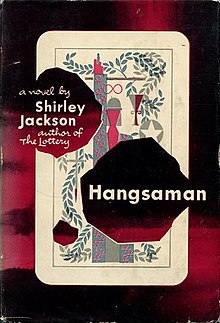Hangsaman
 Cover of first edition | |
| Author | Shirley Jackson |
|---|---|
| Language | English |
| Genre | Speculative fiction | Gothic fiction |
| Publisher | Farrar, Straus and Young |
Publication date | 1951 |
| Publication place | United States |
| Pages | 191 |
| ISBN | 978-0143107040 current edition, published by Penguin |
| Preceded by | The Road Through the Wall |
| Followed by | The Lottery and Other Stories |
Hangsaman is a 1951 gothic novel by American author Shirley Jackson. The second of Jackson's published novels, Hangsaman is a bildungsroman centering on lonely college freshman Natalie Waite, who descends into madness after enrolling in a liberal arts college.[1]
The novel takes its title from an old folk ballad. The official publisher's description of Hangsaman says the novel is “loosely based on the real-life disappearance of a Bennington College sophomore in 1946," referencing the case of Paula Jean Welden.[2] At the time, Jackson was living in Bennington, Vermont, as her husband, Stanley Edgar Hyman, was employed at Bennington College, where Welden had been a student.[1] However, Ruth Franklin's research for her 2016 biography of Jackson found no evidence the novel was inspired by Welden's disappearance.[3] Jackson's text mixes satire with psychological elements as her protagonist spends half her time in an imaginary world.[4]
Plot summary
On the verge of leaving for college, Natalie Waite feels oppressed by the expectations of her pompous, overbearing father, who imposes his personality on her, and by her miserable, defeated mother, who Natalie sees as an example of the unhappy future that awaits her if she does not escape from home. Natalie withdraws into elaborate fantasies where she is a proud, unbreakable criminal being grilled by a detective for her crimes. On the eve of Natalie's departure for college, she is invited to her first adult party, where she witnesses her parents and their drunken colleagues at their most contemptible. Natalie experiments with different identities among the party-goers and seems to successfully intrigue an older man, only to be led by him into the woods behind the family's home where he sexually assaults her.[5] The following morning, Natalie convinces herself that the assault did not happen.
Natalie leaves for her all-female college, where she is determined to reinvent herself. Most of her fellow students are too superficial and self-absorbed to even notice Natalie, who finds an uncomfortable place at the fringe of a group of popular girls, while her self-important professors and their resentful wives are not much different from her own parents. She resumes her fantasy life, imagining herself as an implacable giant that destroys the college and devours its residents.
Natalie hears rumors of an impish student named Tony who is both scorned and secretly admired for her lack of conventionality. Natalie is determined to find and befriend Tony, but Tony seeks her out first. Natalie becomes totally absorbed with Tony, and together they embark on a series of eccentric adventures where they revel in their difference from and superiority to those around them. Natalie's reputation suffers due to her strange new behavior, but for the first time in her life, she no longer cares how others perceive her, even as Tony begins to lure her into increasingly dangerous situations.
On a stormy afternoon, Tony persuades Natalie to take a bus to an unfamiliar location miles from the college. Tony guides her to a lake with a closed amusement park, and Natalie follows her into a small forest. In the fallen darkness, Natalie loses Tony and sits on a log to wait for her. When Tony reappears, Natalie tells her she wants to go home and sets off on her own. She gets a ride home from a couple who tell her they have a daughter the same age as her. They discuss what could happen to a girl on her own and what parents don't know about their children's lives before dropping her off at a bridge near her school. In a nod to the last conversation she had with her father, who stated that a shift in perspective, such as a suicidal frame of mind, was necessary to clearly see one's worthiness, Natalie briefly considers jumping off the bridge. Finally, she turns back towards the college feeling powerful, unafraid, and grown up.[1]
References in other media
The 2020 film Shirley is a fictionalized account of the time in which Jackson was writing Hangsaman, depicting the novel's creation as being inspired both by the Welden disappearance and the life of a boarder in the home of Jackson and her husband Stanley Hyman.[6]
References
- ^ a b c "Shirley Jackson's Horror Novel 'Hangsaman' Was Inspired By A Real-Life Disappearance". Bustle. Retrieved 2019-10-31.
- ^ "Shirley Jackson's Horror Novel 'Hangsaman' Was Inspired By A Real-Life Disappearance". Bustle. Retrieved 2020-07-12.
- ^ "What 'Shirley' gets very wrong about Shirley Jackson". Los Angeles Times. 2020-06-12. Retrieved 2020-07-12.
- ^ Parks, John G. (1984). "Chambers of Yearning: Shirley Jackson's Use of the Gothic". Twentieth Century Literature. 30 (1): 15–29. doi:10.2307/441187. ISSN 0041-462X. JSTOR 441187.
- ^ Havrilesky, Heather. "Haunted Womanhood". The Atlantic. No. October 2016. Emerson Collective. Retrieved 17 October 2020.
- ^ Sims, David (2020-06-08). "'Shirley' Is an Unconventional Biopic About a Horror Master". The Atlantic. Retrieved 2020-07-12.
